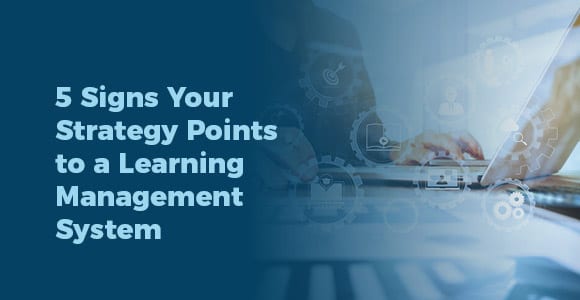
by Amber Winter of Web Courseworks
As you and your team evaluate your learning business’s development and progress, one of the key components you’re sure to examine is your overarching strategy. What plans do you have in place to achieve your goals, how are you measuring your progress toward them, and how close have you come to reaching important milestones?
As one of the five domains of the Learning Business Maturity Model, your strategy is a major determinant of the stage of maturity that your learning business has reached. A more clearly identified strategy, one that everyone on your team understands and that you can track through definable metrics, is indicative of an organization that has reached the higher stages of maturity.
To leverage your strategy to achieve definable results, your learning business will also need the capacity to put that strategy into action. One major component of your learning business’s capacity is the technology you use.
Does your learning business strategy face implementation challenges based on the limitations of your existing technology? You may want to consider implementing a new or replacement learning management system (LMS) if you believe:
- You need up-to-date technology to implement your strategy.
- You’re unable to report your top-performing courses.
- You need to measure and track your learners’ progress.
- You need to expand the reach of your education programs.
- You need to rapidly develop more courses.
A learning management system can help your learning business strategy take shape and measure its effectiveness. Let’s consider each of these needs in more detail.
1. You need up-to-date technology to implement your strategy.
Once you’ve decided what courses to offer, you need a way to get your learners registered for them and learning. A learning management system can help you implement your strategy by allowing you to create courses that address your learners’ most pressing needs.
An up-to-date learning management system is one that allows you to create new courses and refresh current ones as needed to meet your learners’ changing needs. If you’re considering a learning management system to help implement your strategy, you’ll want to consider features such as:
- Course-authoring abilities. Creating your own course material, as well as the sequence in which it’s presented, helps your learners learn more efficiently and helps you structure and prioritize information to meet your goals.
- Customizable assessments. You can create assessments that focus on the most important information within your courses and provide your learners with the feedback they need to progress and succeed.
- Integration with your current systems. If you want to incorporate the information you already have stored in your other software systems, look for an LMS that integrates with those systems. This makes it easier to create courses and help your learners track their credits.
- Alignment with your business requirements. Your learning business’s structure and goals are unique, so your LMS should be able to meet your business’s specific requirements. Some learning management systems are rigid and lack configuration options. Be sure you know what goals you’ll need to track, and then select an LMS that supports those goals.
With a learning management system that makes it easy to create and improve courses, you’ll be able to facilitate your learners’ learning processes even as their educational needs and interests evolve.
Implementing your learning business’s strategy is an important step in the process toward maturity and innovation. Once you’ve created courses for your learners, it’s essential that you’re able to track how well each course is performing.
2. You’re unable to report your top-performing courses.
Your learning business strives to create courses that learners find engaging and informative. Tracking the performance of each of your courses provides insight into their popularity and efficacy as learning tools. You can use your learning management system’s reporting features to track your courses’ performance, identifying successes as well as areas for improvement.
Reporting features provide information that can help you determine which courses to promote, revise, or replace. You’ll want to be able to identify:
- The courses that learners are buying. Identify your top-selling courses to help you determine what content and features learners are looking for when they purchase courses. When you choose a learning management system that links to your e-commerce platform, you’ll be able to access this information easily.
- The courses that learners attend. When your learners attend certain courses regularly, this indicates that these courses present the information in an engaging manner. An LMS can report on your most-attended courses, and you can use this information to identify course structures and presentation styles that resonate with learners.
- The courses that learners learn from. Your learning business’s goal is to create courses that help learners learn, so it’s essential that you’re able to track their performance in your courses. Courses that are designed effectively are likely to have high success rates among learners.
When your learning business is able to identify your top-performing courses quickly and easily, you’ll be able to identify similarities among courses that sell well, encourage learners to attend, and have high success rates. You can then use their structure and components to design future courses as your learning business grows.
If designed with education’s third sector and on-the-job learning in mind, an LMS can be an ideal solution for learners to access courses that teach them important new skills. To create the best courses to suit their needs, however, your learning business will need to be able to track their progress so that you can make adjustments and create new courses as needed.
3. You need to measure and track your learners’ progress.
Even the most comprehensive and clearly understood strategy can’t help your learning business achieve its goals unless you’re able to measure your learners’ progress. Your learning management system can help you uncover what your learners understand well and where they still need practice.
Learning management systems are capable of providing highly accurate information regarding learners’ progress and their readiness to move on to new material.
Your learning management system’s reporting features can let you know which objectives your members are excelling at and which they’re struggling with. You can track individual learners’ progress on each objective or portion of the course and see how all enrolled learners are doing on a particular objective or course section.
Want to make sure that your learners are focusing on a particular objective or portion of the course? Tailor your assessment to emphasize that component, and ensure that your LMS provides learners who miss questions related to it with plenty of information in the correction so that they’re sure to understand it.
Leveraging your learners’ data is essential to the development and progress of your learning business, so tracking their progress on each objective is important. You’ll understand where your education program is meeting their needs and where you need to modify or expand it.
4. You need to expand the reach of your education programs.
As learners purchase and enroll in your courses, your learning business will be able to track the ways in which your courses meet your learners’ needs as well as identify areas for improvement. When it comes time for you to expand your course offerings to better meet your learners’ needs, your learning management system can provide data to help shape your new direction.
A more mature learning business is one that is able to use learner data collected over time to determine how best to meet changing needs by adding and updating course offerings. Using your learning management system, you’ll be able to adjust your courses as needed should you see that:
- Some of your courses aren’t popular with learners. Your LMS’s reporting features, especially when linked with your e-commerce platform, can alert you to courses that aren’t selling. From this information, you’ll be able to determine whether these courses don’t contain the information most relevant to your learners or whether they’re not structured to meet your learners’ needs.
- Attendance is falling in some of your courses. Courses that your learners don’t attend can’t be effective learning tools. Your LMS can help you track attendance numbers and trends for the courses you offer, providing insight into which ones need to be updated to be more engaging to learners.
- Some of your courses need their content refreshed. Learners’ needs and interests change over time. With the right technology, your learning business can keep up with and even ahead of these changes by refreshing the content and structure of courses when learners need additional material.
Learning management systems are designed to be flexible, addressing the rapidly changing learning needs in a variety of fields. The most effective systems are those that use the most up-to-date technology to help your learning business meet your learners’ developing needs. In addition to updating courses for this purpose, you may find that you need to add more.
5. You need to rapidly develop more courses.
One of the main advantages of using a learning management system is that it incorporates recent technological developments in your education programs. Take advantage of new features, unique to e-learning and LMS platforms, which can help your learners access new information quickly and explore the education programs your organization has to offer.
As your learning business matures, it’s also likely to grow—especially if you and your learners work together to reach your goals using an effective strategy! Your growth means that the LMS size you started with may not suffice once your learning business reaches its new stage. Switching systems is far from the best use of you and your members’ times, however.
The answer? Choose an LMS that can grow with your learning business, allowing you to add courses and programs as your business grows, your goals expand, and your strategy transforms. This way, you’ll set the stage to be the center of learning for your members and bring your learning business closer to maturity.
The Bottom Line
A learning management system can help your learning business implement your strategy by providing the technology you need to create, update, and distribute the courses that your learners need. With the ability to track the performance of your courses and your learners’ progress within them, you’ll know where to make necessary adjustments and provide the best possible learning materials.
About the Author

Amber Winter is the vice president of sales and service at Web Courseworks, where she is committed to helping learning business leaders realize the potential of their education programs and turn them into high-performing revenue-generators. Amber was named one of In Business Greater Madison’s 2018 “40 Under 40” and the No. 1 LMS Salesperson by Talented Learning.

 Cultivating Communities with Rachel Happe of Community Roundtable
Cultivating Communities with Rachel Happe of Community Roundtable
Leave a Reply